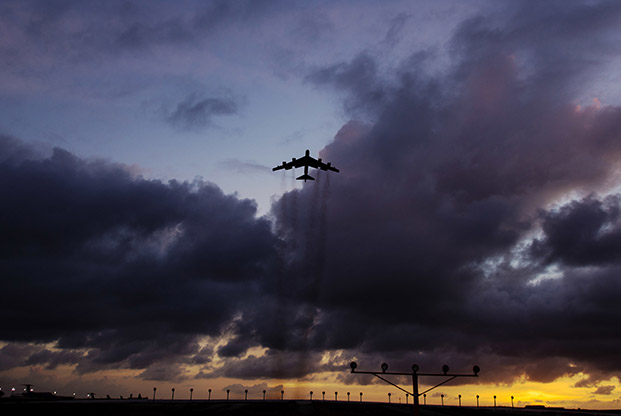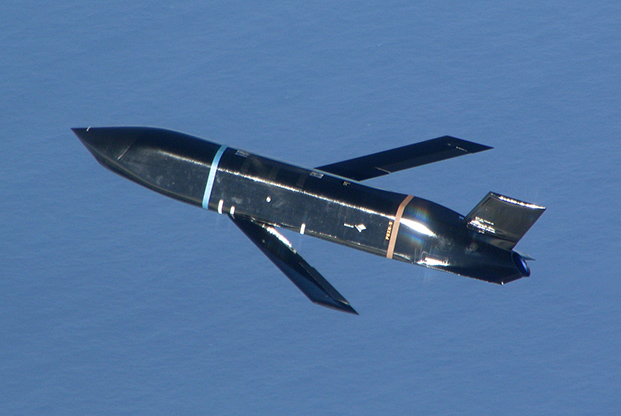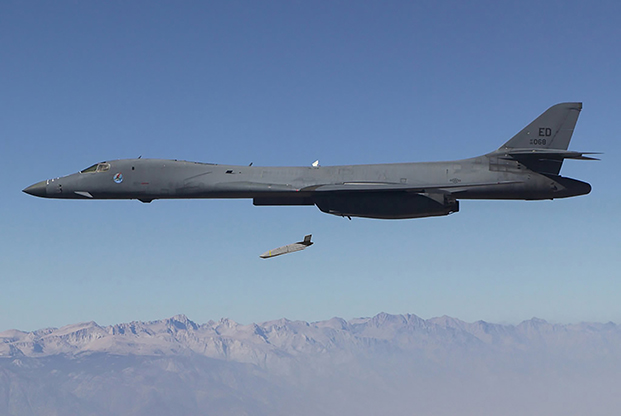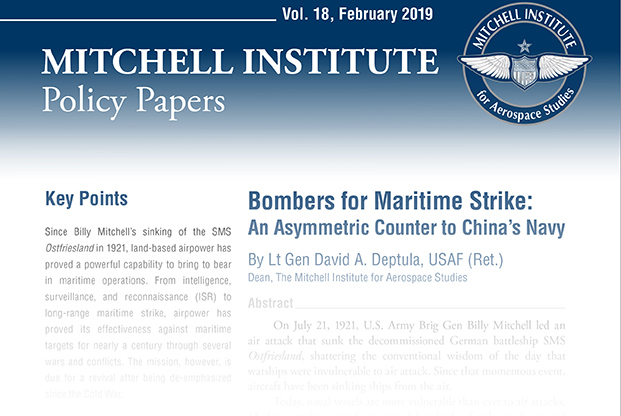 A B-52 takes off from Andersen AFB, Guam. A B-52 can carry eight to 12 AGM-84 Harpoon anti-ship missiles, as well as 20 AGM-158 joint air-to-surface missiles. Photo: SrA. Ryan Brooks
A B-52 takes off from Andersen AFB, Guam. A B-52 can carry eight to 12 AGM-84 Harpoon anti-ship missiles, as well as 20 AGM-158 joint air-to-surface missiles. Photo: SrA. Ryan Brooks
On July 21, 1921, US Army Air Service Brig. Gen. Billy Mitchell sank the decommissioned German battleship SMS Ostfriesland, shattering the conventional military wisdom that such ships were invulnerable to air attack. Combat aircraft have been sinking ships from the air ever since.
Modern combat aircraft can travel hundreds of miles an hour, patrol vast expanses of geography, and extend their reach with standoff weapons. US Air Force bomber forces, with their speed, maneuverability, stealth and advanced weapons and sensors afford superior survivability compared to naval vessels.
In a modern threat environment, especially in the Asia-Pacific region, the advantages of using bombers in a maritime strike role is becoming more relevant to future military strategies, plans, and budget priorities.
Indeed, US Indo-Pacific Command (INDOPACOM) has already carried out test exercises to demonstrate bombers’ great capability and operational flexibility against potential adversaries with significant offensive naval capability. Modern weapons, such as the long-range anti-ship missile (LRASM), give the US a significant capability from bomber aircraft against hostile surface vessels. Pairing LRASM with modern sensors, bomber aircraft can now conduct all-weather precision engagements against mobile maritime targets with less risk than naval vessels, and do so in hours, rather than days or weeks.
 Click here or on the graphic above to view Air Force Magazine’s map of how US airpower can offset China’s expanding airpower as a PDF. Photo: Zhang Lei/China Ministry of Defense; teaser graphic by Dashton Parham.
Click here or on the graphic above to view Air Force Magazine’s map of how US airpower can offset China’s expanding airpower as a PDF. Photo: Zhang Lei/China Ministry of Defense; teaser graphic by Dashton Parham.
HISTORY OF AIRPOWER AND MARITIME STRIKE
American military interest in employing land-based airpower in counter maritime operations has risen and fallen over the decades, along with the perceived naval surface threat of enemies and potential adversaries. In World War II, the US Army Air Forces conducted reconnaissance, anti-submarine warfare, mine laying, and anti-shipping attacks against the German and Japanese navies. But for decades after World War II, interest in the Air Force’s maritime operations languished with a lack of significant enemy naval threats. In that era, the Air Force realigned to focus on nuclear bombardment and minimized conventional maritime operations while the Navy de-emphasized surface warfare and focused on building up naval aviation.
That changed in the 1970s, as the Soviet Union built up and deployed a large, global fleet equipped with powerful, long-range anti-ship weapons. The Soviet buildup occurred as the US Navy was shrinking and the Vietnam War was winding down. Between 1969 and 1979, the US Navy’s active fleet shrunk from 1,007 to 540 ships. In contrast, the Soviets built powerful new surface ships with large missile payloads, deploying weapons such as the SS-N-19 “Shipwreck” anti-ship missile aboard the nuclear-powered Kirov-class cruisers. By 1979, the Soviet navy fleet stood at 1,764 active vessels. Soviet naval aviation also deployed land-based bombers, such as the Tu-95 Bear, Tu-16 Badger, and Tu-22 Backfire, all armed with long-range anti-ship missiles.
In response to this buildup, interest in the Air Force’s contribution to maritime operations resurged. In 1975, the Air Force agreed to train air crews in ocean surveillance, maritime strike, and aerial mine laying in cooperation with the Navy. B-52s began conducting ocean surveillance missions in the Atlantic and Pacific and regularly trained with the Navy in the conduct of these missions. By 1983, B-52 bombers armed with AGM-84 Harpoon anti-ship missiles were stationed in Maine and Guam to counter Soviet naval forces. A concept of operations took shape that envisaged groups of B-52s under the control of a Navy E-2C or P-3, or an Air Force E-3A AWACS, attacking Soviet naval surface forces. As many as 10 B-52s could descend to low altitude, approach from different directions, and launch salvos of Harpoons to saturate defenses. In addition to the B-52’s large missile capacity, and the fact that it could replenish its weapons in hours versus the days or weeks ships required, it also had the range to attack enemy naval surface groups before they came within range of US Navy ships.
With the end of the Cold War, however, the military services downsized these capabilities as part of the “peace dividend.” Without the Soviet threat, the US Navy shrank again, from a total active force of 592 vessels at the end of the Cold War to 287 today. This reduction was ostensibly offset by an increase in the number of missile tubes aboard each ship. In the late 1980s, the surface fleet boasted some 5,000 missile launch tubes. These were composed of around 3,300 vertical launch system (VLS) tubes and 1,600 others, such as those for the AGM-84 Harpoon missile. Today’s Navy surface fleet has nearly 9,000 VLS tubes.
In reality, more missile tubes do not necessarily translate into more maritime strike power. Most of those tubes are armed with defensive anti-aircraft missiles to protect the battle group and ballistic missiles; offensive missiles amount to only one-quarter to one-third of a typical ship’s VLS loadout, and most of these are Tomahawk land-attack cruise missiles (TLAM)—not anti-ship or anti-submarine weapons.
In a crisis, the Navy would have to make tradeoffs in its standard loadout, adding more anti-ship and anti-submarine weapons and likely giving up TLAM capacity in the process—provided it had time and warning to do so. VLS tubes cannot be loaded while underway, requiring a port call unless an ungainly crane is added—at the cost of three VLS tubes. The air-defense missile loadout would have to be preserved or expanded as well to defend against air attacks.
In the Asia-Pacific area of operations, with its vast distances, land-based airpower’s maritime strike capacity could prove vital. New weapons have increased airpower’s capability for this mission. The Navy has developed the AGM-158C long-range anti-ship missile, an anti-ship variant of the SM-6 standard missile, and the naval strike missile (NSM). The SM-6 has a range exceeding 250 nautical miles (nm), and though it has a light warhead, it boasts enormous kinetic energy due to its Mach 3.5 speed. The LRASM has a range over 200 miles, and like the Tomahawk, has a 1,000-lb warhead. Surface Navy ships, the F/A-18 Super Hornet, and the B-1B bomber are all slated to employ LRASM. The NSM, as well, is considered a very stealthy weapon with a range of around 100 nm.
The capabilities of Air Force bombers are also being considered while the Navy is trying to halt and then reverse the decline in the size of its active fleet. The Navy’s plan anticipates a 342-ship active fleet by 2040, an upward trend but short of its goal of 355 ships. Only a portion will be deployed in the Western Pacific at any given time, however, and only about 100 ships will be forward deployed on any given day in peacetime. The remainder are either in maintenance or training or in transit to or from forward locations. In 2015, out of 272 ships, there were around 54 in the Western Pacific, 24 in the Indian Ocean, and 13 in the Mediterranean; plans call for increasing presence in the Western Pacific to around 67 ships by the 2020s. In the event of a conflict with China, the US Navy would be at a tactical disadvantage as the Chinese would be able to surge most of its naval assets from nearby ports against only 20 percent of the entire American Navy.
 Long-Range Anti-Ship Missiles (LRASM), with 1,000-pound warheads and a range of more than 200 miles, are slated to be employed by USAF B-1Bs as well as Navy assets. Photo: Lockheed Martin
Long-Range Anti-Ship Missiles (LRASM), with 1,000-pound warheads and a range of more than 200 miles, are slated to be employed by USAF B-1Bs as well as Navy assets. Photo: Lockheed Martin
THE CHALLENGE OF CHINESE NAVAL AIRPOWER
This situation harkens back to the Soviet naval buildup of the 1970s. Having built up its naval power over the past two decades, China can now pose a challenge to the US Navy in the region. The Chinese surface fleet grown not only in size, but also capability. China has invested in new ground- and air-launched anti-ship cruise missiles (ASCMs), ballistic missiles, new submarines, modern aircraft, large-deck aircraft carriers, and other naval assets.
This modernization effort has accelerated as the Chinese have shed older force structure. In 2000, the Chinese surface fleet consisted of 21 destroyers, 35 frigates, and 87 missile patrol boats, most of which were built before 1990. Today, China boasts 27 destroyers, 49 frigates, 40 corvettes, and 112 missile patrol boats—60 percent more assets than it had in 2000. Three-quarters of its surface fleet today was built after 2000. These ships have modern VLS tubes and phased array radars, as well as fleet air defense systems such as the HHQ-9 surface-to-air missile system (SAM), with a range of around 108 nm. China has also modernized its submarine and naval aviation fleets and developed new weapons, such as the DF-21D anti-ship ballistic missile (ASBM), a new form of anti-ship weapon with a range of around 810 nm that features maneuverable re-entry vehicles and the ability to strike moving targets such as, specifically, US Navy aircraft carriers. Tying all of these capabilities together is a ground-based, over-the-horizon targeting radar that detects, identifies, and targets US ships in the Western Pacific. Collectively, these assets could deny American surface vessels access to waters from which these ships could strike Chinese land and naval targets.
While the operational potency of this force is subject to debate, the Chinese navy is now conducting increasingly complex, sustained, and combined arms training; is more proficient than ever in anti-surface warfare; and has proved increasingly capable in air defense. Given this evolving threat, what are the options for increasing US offensive striking power
The US Navy wants to build more ships and submarines to keep parity with the Chinese navy, but this option is a very costly way to increase offensive power. The Congressional Budget Office in 2017 estimated that the cost to increase the Navy fleet from 308 ships to 355 would add 13 percent to the budget ($102 billion versus $90 billion a year) and would necessitate increasing Navy personnel strength by 48,000 people. Yet more ships do not yield a proportional boost in operationally significant fire power. For each additional Burke-class guided missile destroyer, for example, only 20 to 30 of its 96 VLS tubes could be used for anti-ship missiles.
Nor could those ships rely on submarines, which would almost certainly be focused on anti-submarine warfare and land attack using TLAMs in the opening days of any conflict. Carrier-based strike aircraft, meanwhile, have relatively limited payloads and range. The F/A-18 can only carry a pair of LRASMs, for example, and even with the capabilities of an F-35C to draw on, if a carrier had to remain east of Guam due to anti-ship missile threats, a maximum-range LRASM strike would not penetrate far into the Philippine Sea. This means carrier-based aircraft would have extreme difficulty approaching enemy targets in the Western Pacific and East Asia, and any subsequent strikes would depend on the availability of munitions onboard aircraft carriers and replenishment ships.
 A B-1B bomber tests a LRASM prototype in 2013. DARPA and the Office of Naval Research collaborated on the weapon. Photo: DARPA
A B-1B bomber tests a LRASM prototype in 2013. DARPA and the Office of Naval Research collaborated on the weapon. Photo: DARPA
BOMBERS-ASYMMETRIC MARITIME STRIKE
Rather than a costly naval buildup that might not achieve the necessary increase in maritime striking power to meet the demands of our national military strategy, an asymmetric—and truly joint—approach is to rely on Air Force bombers to increase US maritime strike capability.
This is by far the most cost-effective option available to achieve the desired effect. B-52, B-1B, and B-2 bombers are developed, deployed, and operational today and the B-21 now in development will also conduct maritime strike. The B-21 is already programmed into the Air Force’s budget and will add to this capability once deployed. The primary cost to the Air Force will come from developing additional naval-strike capabilities for these aircraft such as acquiring new ASCMs, training bomber crews in maritime operations, and expanding efforts to ensure robust Air Force-Navy maritime strike interoperability.
The reasoning behind using bombers today is very similar to why they were called on in World War II and during the Cold War. These are large aircraft, designed to carry large payloads and travel long distances at speeds 30 to 40 times faster than ships, while requiring a fraction of the resources and manpower to achieve commensurate combat effects. A B-52H can carry 8 to 12 Harpoon anti-ship missiles, along with 20 AGM-158 joint air-to-surface standoff munition (JASSM) weapons. The JASSM is the weapon the LRASM is based on and has the same size and weight characteristics. In comparison, the B-1B can carry 24 JASSM-class weapons, and the B-2 can carry 16. To date, the B-1B is the only one of the three that has launched an LRASM, but both the B-52 and B-2 could be adapted easily to carry them. Other weapons could also be used in the maritime strike mission aboard bombers. Though Air Force aircraft have never launched Tomahawk cruise missiles, it is slightly smaller and lighter than the AGM-86C/D conventional air-launched cruise missile—of which a B-52 can carry 20. The US Navy is slated to deploy an anti-ship variant of the Tomahawk in the 2020s. Thus, the possibility of integrating an anti-ship variant of the Tomahawk onto B-52s and B-1Bs should be investigated as a possibility to enhance maritime attack capabilities for little additional investment.
Long-range strike weapons and cruise missiles could generate a large amount of flexible strike capacity onboard Air Force bombers. Putting Tomahawks on bombers could hold vessels in the Chinese littorals at risk, outside the range of ground-based air defenses, while a single bomber equipped with LRASMs could launch a salvo equal to that of a destroyer or submarine—and two bombers could launch as many as an entire carrier air wing. In addition to the strike flexibility of their weapons, the range and speed of bombers allow for great operational flexibility in the maritime mission. All three Air Force bomber types have flown numerous long-range sorties from bases in the United States to strike targets in Asia, then safely returned home. The unrefueled combat radius of Air Force bombers—the maximum distance they can travel to a target and return—is between 2,500 and 4,500 nm, depending on the variant and payload. With this range bombers can strike from distant bases safe from enemy attack, approach from unpredictable directions, and attack from multiple azimuths simultaneously.
Bombers’ relative speed advantage over surface naval vessels enables these aircraft to strike targets on short notice, anywhere on Earth. Bombers can also be deployed from bases within the Asia-Pacific theater to increase their flexibility. A B-1B, for example, could strike maritime targets in the Western Pacific within 13 hours of taking off from the continental US, while a bomber in Hawaii could strike the same targets in under nine hours, with a single refueling each way. Bombers in Australia could reach the Western Pacific in under six hours with no refueling. Speed also gives bombers rapid re-strike capability, as they could return to base, reload, and launch new strikes in hours. By contrast, submarines and ships could take over a week to replenish their weapons stocks. Even accounting for forward anchorages or replenishment underway, bombers could launch far more weapons in a comparable timeframe.
The mobility of maritime targets presents a complex targeting and cueing problem. However, in just two hours, two B-52s can monitor 140,000 square miles (364,000 square kilometers) of ocean surface—orders of magnitude greater than possible with two surface ships. This mission area also epitomizes the potential to engage via a “combat cloud” approach that links together various sensor and shooter aircraft and surface platforms. In the 1980s, the Air Force and Navy practiced strike cueing by using the E-2C, P-3, and E-3A AWACS to cue B-52s. In 2004, as Pacific Air Force’s director of operations, I orchestrated the “Resultant Fury” test exercise demonstrating that an E-8 JSTARS aircraft could find and track maritime targets and pass that information to B-52s and their weapons to strike ships under way. The Navy’s P-8 and MQ-4C remotely piloted aircraft can also detect and track maritime targets and share that information to bombers. Networking capability has steadily improved across the Air Force and Navy. With improved sensor technology, continued experimentation, and exercising, further improvements can be made, enhancing joint strike capacity for combatant commanders. At the same time, improving survivability for non-stealthy bombers will require increased attention as ship-based air defense missiles will increase in range and effectiveness over time.
A compelling operational solution for finding and tracking maritime targets in an environment filled with high-threat air defenses is to employ stealth aircraft such as the B-2 and the B-21. These bombers have the range and endurance to find enemy surface ships within close proximity of their targets, and then are capable of transmitting precise data to both stealthy and non-stealthy shooters to take advantage of the ranges of their respective weapons. Stealth bombers can also attack maritime targets in closer proximity with larger numbers of smaller weapons, while B-1Bs could strike at distance using LRASMs—severely complicating the defensive problem for Chinese surface ships or other adversary forces.
COST-EFFICIENT COUNTER TO CHINA’S NAVY
In summary, there is an emerging gap in US naval anti-surface warfare capability, particularly in the Western Pacific region. China is deploying a large and growing number of capable combatant ships, submarines, and aircraft armed with short and long-range ASCMs. The ability of the US Navy alone to counter these threats with its surface ships, submarines, and carrier-based aircraft is limited. The US Air Force can provide a cost-effect solution to meet the challenges posed by China in the Pacific by renewing training and equipping its bombers for maritime strike missions.
Air Force bombers can launch large salvos of ASCMs and other weapons at short notice and from multiple directions. Stealth bombers can penetrate the umbrella of Chinese air defenses to threaten and destroy Chinese naval assets. These aircraft can also cue non-stealthy aircraft and other shooters for over-the-horizon strikes, further complicating adversary defensive calculations.
US Air Force bombers offer joint and combined combatant commanders a strong, cost-effective, and efficient deterrent to Chinese naval power; bolster US Navy and allied forces in continuing efforts to counter China; and enhance American national security options to respond to potential Chinese aggression in the Asia-Pacific theater and around the globe.
___
Lt. Gen. David A. Deptula, USAF (Ret.) is Dean of the Mitchell Institute for Aerospace Studies.
This article is adapted from the Mitchell Institute Policy Paper, Bombers for Maritime Strike: An Asymmetric Counter to China’s Navy, which can be downloaded in its entirety at: http://www.mitchellaerospacepower.org.
